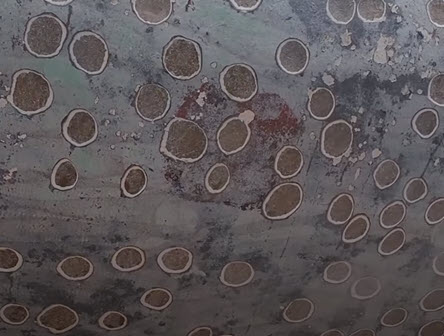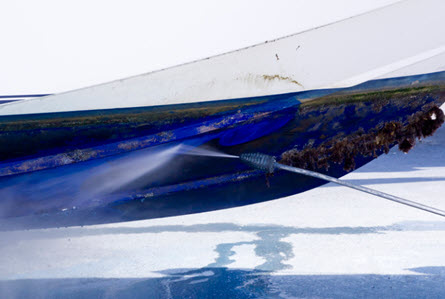As boat owners, maintaining the integrity of our vessels is paramount. Yet, lurking beneath the surface of many fiberglass hulls lies a common adversary: blisters. I’ll walk you through the ins and outs of how to identify and repair fibreglass hull blisters, providing you with the tools and know-how to tackle this issue head-on.
Because these small, often unseen bubbles can wreak havoc if left unchecked, compromising the structural integrity and seaworthiness of your boat.
Whether you’re a seasoned sailor or a novice boat owner, understanding how to address blisters is essential for safeguarding your investment and ensuring many smooth sailing seasons ahead. So, let’s dive in and get to the bottom of this blistering issue.
Table of Contents
Understanding Fiberglass Hull Blisters
Fiberglass hull blisters are small, dome-shaped protrusions that form on the surface of a boat’s hull. They are typically filled with fluid, which can vary in composition from water to a mixture of water, resin, and other contaminants.
While blisters may seem innocuous at first glance, they can signal underlying issues that, if left untreated, can compromise the structural integrity of the hull.
How do They Form and Why are They Common?
Blisters form due to a process called osmotic blistering, which occurs when water penetrates the outer gel coat layer of the fiberglass laminate and reacts with soluble compounds within the laminate.
This reaction creates pressure, causing the laminate to delaminate and form blisters. Several factors contribute to the formation of blisters, including prolonged exposure to water, osmotic pressure, temperature fluctuations, and poor construction practices.
Fiberglass boats are particularly susceptible to blistering due to the permeable nature of fiberglass laminates and the presence of water-soluble compounds in the resin.
Consequences of Ignoring or Neglecting Blisters
Ignoring or neglecting blisters can have serious consequences for the structural integrity and performance of your boat. Over time, blisters can lead to further delamination of the laminate, weakening the hull and increasing the risk of catastrophic failure.
In addition to compromising safety, untreated blisters can also affect the resale value of your boat, as they are often viewed as a sign of poor maintenance. Addressing blisters promptly is essential to prevent further damage and ensure the long-term durability of your vessel.
Visual Inspection
- Clean the Hull: Before inspection, ensure the hull is clean and free of any debris or marine growth that may obscure your view.
- Start at the Waterline: Begin your inspection at the waterline and work your way down, thoroughly examining the entire hull surface.
- Look for Raised Bumps or Blisters: Keep an eye out for raised bumps or blisters on the hull surface. Blisters may vary in size and appearance, ranging from small pinheads to larger, more pronounced domes.
- Check for Discolouration: Blisters often manifest as discoloured areas on the hull, appearing as dark spots, cloudy patches, or areas of irregular texture.
- Use a Bright Light: Shine a bright light at a low angle across the hull surface to highlight any imperfections or irregularities. This technique can help reveal blisters that may be less visible under normal lighting conditions.
Key Areas of Concern
- Below the Waterline: Blisters are most commonly found below the waterline, where the hull is in constant contact with water. Pay close attention to this area during your inspection.
- Near Fittings and Through-Hull Penetrations: Blisters are more likely to form around fittings, through-hull penetrations, and other areas where the hull has been penetrated, as these areas are susceptible to moisture intrusion.
Differentiating Between Blisters and Other Damage
- Gel Coat Damage: Blisters may initially resemble gel coat damage, but they typically have a distinct raised or domed appearance compared to surface scratches or cracks.
- Osmosis vs. Impact Damage: Blisters caused by osmotic blistering often appear as multiple small bumps clustered together, whereas impact damage may result in isolated areas of damage with a more irregular shape.
- Moisture Meter Testing: If unsure, consider using a moisture meter to assess the moisture content of the affected area. Blisters often contain trapped moisture, which can be detected using a moisture meter.
By following these steps and paying close attention to key areas of concern, you can effectively identify fiberglass hull blisters and distinguish them from other types of hull damage. Early detection is key to addressing blisters promptly and preventing further deterioration of the hull.
Assessing the Severity of Blisters

- Minor Blisters: These are small, isolated blisters that are superficial and do not extend deep into the laminate. They may appear as tiny bumps or irregularities on the hull surface.
- Moderate Blisters: Moderate blisters are larger in size and may be more numerous than minor blisters. They can affect the structural integrity of the laminate to some extent but typically do not pose an immediate threat to the hull’s integrity.
- Severe Blisters: Severe blisters are large, extensive, and often numerous. They may penetrate deep into the laminate, causing significant delamination and compromising the structural integrity of the hull.
Tips for Assessing Blister Severity
- Size and Number: Evaluate the size and number of blisters present on the hull. Multiple or large blisters may indicate a more severe problem than isolated or small blisters.
- Depth of Penetration: Use a sharp tool or moisture meter to assess the depth of blister penetration into the laminate. Deeper blisters are more likely to compromise the structural integrity of the hull.
- Extent of Delamination: Inspect the surrounding area for signs of delamination, such as soft or spongy spots on the hull surface. Severe delamination indicates a more advanced stage of blistering and may require immediate attention.
- Presence of Secondary Damage: Look for signs of secondary damage, such as cracks, fractures, or discolouration, in the vicinity of the blisters. Secondary damage suggests that the blistering problem may be more extensive than initially apparent.
Determining the Need for Immediate Attention
- Safety Concerns: If blisters have compromised the structural integrity of the hull or pose a safety risk, such as the risk of water ingress or hull failure, immediate attention is warranted.
- Extent of Damage: Evaluate the extent of blistering and associated damage to determine whether repairs can be deferred or require immediate action. Severe blisters with extensive delamination typically require prompt repair to prevent further deterioration.
Monitoring Over Time
- Regular Inspections: Schedule regular inspections to monitor the progression of blisters and assess any changes in severity over time. Keep detailed records of inspection findings to track the evolution of the problem.
- Consultation with Experts: Seek advice from marine surveyors or boat repair specialists to help determine the appropriate course of action for managing blistering issues. They can provide valuable insights and recommendations based on their expertise and experience.
By understanding the different types and degrees of blister severity and following these tips for assessment, boat owners can make informed decisions about when to address blistering issues and whether immediate attention is required.
Regular monitoring and consultation with experts can help mitigate risks and ensure the long-term integrity of the hull.
Repairing Fiberglass Hull Blisters
Materials and Tools Needed for Blister Repair
- Epoxy Resin: Choose a marine-grade epoxy resin suitable for fiberglass repair.
- Fiberglass Cloth or Mat: Use fiberglass cloth or mat to reinforce the repair and provide strength.
- Filler Compound: Select a fairing filler compound to smooth out the repaired area.
- Barrier Coat: Use a high-quality barrier coat to prevent moisture intrusion and protect the repaired area.
- Sandpaper and Sanding Blocks: Use various grits of sandpaper and sanding blocks for surface preparation and finishing.
- Cleaning Solvent: Use a suitable cleaning solvent to remove contaminants and prepare the surface for repair.
- Protective Equipment: Wear protective gear, including gloves, goggles, and a respirator, when working with epoxy resin and other chemicals.
Step-by-Step Guide to Repairing Blisters
Surface Preparation:
- Clean the Area: Thoroughly clean the blistered area using a cleaning solvent to remove any dirt, grease, or contaminants.
- Dry the Surface: Allow the cleaned area to dry completely before proceeding with repairs. Moisture trapped in the laminate can compromise the effectiveness of the repair.
- Sand the Surface: Use coarse sandpaper to sand away the gel coat and expose the fiberglass laminate beneath. Feather the edges of the blister to create a smooth transition between the repaired area and the surrounding hull.
Filling and Fairing:
- Apply Epoxy Resin: Mix the epoxy resin according to the manufacturer’s instructions and apply it to the prepared surface using a brush or roller.
- Lay Fiberglass Cloth or Mat: Place a layer of fiberglass cloth or mat over the wet epoxy resin, ensuring full coverage of the blistered area.
- Wet-Out the Fiberglass: Use a brush or roller to saturate the fiberglass cloth or mat with additional epoxy resin, ensuring it adheres to the hull surface and eliminates air bubbles.
- Fill and Fair: Once the fiberglass has cured, apply a fairing filler compound to smooth out the repaired area and create a seamless transition between the repair and the surrounding hull.
Applying Barrier Coatings:
- Apply Barrier Coat: After the fairing filler has cured, apply multiple coats of a high-quality barrier coat to the repaired area and surrounding hull. Barrier coats help prevent moisture intrusion and protect the repair from future blistering.
Final Finishing and Painting:
- Sand and Finish: Once the barrier coat has cured, sand the repaired area smooth using progressively finer grits of sandpaper. Ensure a smooth and even surface before proceeding to paint.
- Apply Paint: Apply marine-grade paint to the repaired area, matching the colour and finish of the surrounding hull. Apply multiple coats as necessary to achieve a durable and uniform finish.
Tips for Ensuring a Durable and Long-Lasting Repair:
- Follow Manufacturer’s Instructions: Always follow the manufacturer’s instructions when working with epoxy resin, filler compounds, and barrier coats to ensure proper curing and adhesion.
- Ensure Proper Surface Preparation: Thoroughly clean and dry the repair area before applying any materials to promote adhesion and prevent contamination.
- Use Quality Materials: Invest in high-quality materials and tools for a durable and long-lasting repair. Cheap or inferior products may result in subpar results and require more frequent maintenance.
- Inspect Regularly: Schedule regular inspections to monitor the repaired area for signs of damage or deterioration. Promptly address any issues to prevent further damage to the hull.
- Consider Professional Assistance: If you’re unsure about your ability to repair blisters effectively, consider seeking assistance from a professional boat repair specialist or marine surveyor. They can provide expert guidance and ensure the repair is done correctly.
By following these steps and tips, boat owners can effectively repair fiberglass hull blisters and ensure a durable and long-lasting repair that protects the integrity of their vessel.
Preventing Fiberglass Hull Blisters
Preventing fiberglass hull blisters is essential for maintaining the structural integrity and longevity of your boat. Here are some practical tips to help prevent blisters from forming in the future:

Proper Hull Maintenance:
- Regular Cleaning: Keep your boat’s hull clean by regularly washing it with freshwater to remove salt, dirt, and other contaminants. Avoid using harsh chemicals that could damage the gel coat or laminate.
- Correct Storage: Store your boat properly when not in use, preferably in a dry, well-ventilated area away from direct sunlight. Avoid leaving the boat in the water for extended periods, as prolonged exposure can accelerate blister formation.
- Avoid Impact Damage: Take care to avoid collisions or impacts that could damage the hull and compromise its protective gel coat layer. Use fenders and dock lines to protect the hull when docking or mooring.
Regular Inspections:
- Scheduled Inspections: Conduct regular visual inspections of the hull, both above and below the waterline, to check for signs of blistering, damage, or wear. Schedule professional inspections by a marine surveyor periodically to assess the hull’s condition more thoroughly.
- Moisture Meter Testing: Use a moisture meter to detect any moisture intrusion or delamination within the laminate. Conduct moisture readings at regular intervals, especially in areas prone to blister formation.
Use of Barrier Coatings or Epoxy Barriers:
- Barrier Coatings: Consider applying a high-quality barrier coating, such as epoxy or vinylester resin, during construction or repair to provide an additional layer of protection against moisture intrusion. Barrier coatings help seal the laminate and prevent osmotic blistering.
- Epoxy Barriers: Use epoxy barriers specifically formulated to impregnate the laminate and block moisture penetration. Epoxy barriers can be applied during construction or as part of a blister repair process to reinforce the hull’s resistance to blister formation.
Monitoring and Addressing Moisture Intrusion Issues:
- Inspect Through-Hull Fittings and Seals: Regularly inspect and maintain through-hull fittings, seacocks, and other hull penetrations to ensure they are properly sealed and free of leaks. Address any signs of corrosion, deterioration, or wear promptly to prevent water ingress.
- Addressing Deck Leaks: Check for signs of deck leaks, such as water stains or soft spots, and promptly repair any damaged or deteriorated sealant around fittings, hatches, or windows. Ensure deck hardware is securely fastened and properly sealed to prevent water intrusion into the hull.
- Monitor Bilge Pump Operation: Keep an eye on the operation of your boat’s bilge pump and ensure it is functioning correctly to remove any accumulated water from the bilge. Regularly inspect and clean the bilge area to prevent stagnant water accumulation.
Conclusion
In conclusion, understanding and addressing fiberglass hull blisters are crucial aspects of boat ownership and maintenance. Throughout this guide, we’ve explored the causes, identification, assessment, repair, and prevention of blisters, equipping you with the knowledge and tools to tackle this common issue effectively.
Key Points Covered:
- Fiberglass hull blisters are small bubbles that form on the hull’s surface due to osmotic pressure, moisture intrusion, and other factors.
- Ignoring or neglecting blisters can lead to structural damage, compromising the safety and integrity of the hull.
- Identifying blisters through visual inspection and assessing their severity are essential steps in the repair process.
- Repairing blisters involves surface preparation, filling and fairing, applying barrier coatings, and final finishing and painting.
- Prevention strategies include proper hull maintenance, regular inspections, the use of barrier coatings or epoxy barriers, and addressing moisture intrusion issues promptly.
Importance of Proactive Maintenance and Repair:
Proactive maintenance and repair are paramount for fiberglass hulls to ensure their longevity, safety, and performance on the water. By staying vigilant, conducting regular inspections, and addressing issues promptly, boat owners can mitigate the risk of blister formation and other potential problems, saving time, money, and hassle in the long run.
Encouragement to Take Action:
If you suspect or discover blisters on your boat’s hull, don’t hesitate to take action. Prompt attention to blistering issues can prevent further damage and preserve the integrity of your vessel. Whether you tackle repairs yourself or seek assistance from professionals, addressing blisters early is essential for maintaining the seaworthiness and value of your boat.
Remember, proactive maintenance is the key to enjoying many smooth sailing seasons ahead. So, don’t delay—take charge of your boat’s health and address any blistering issues head-on. Your vessel—and your peace of mind—will thank you for it.
